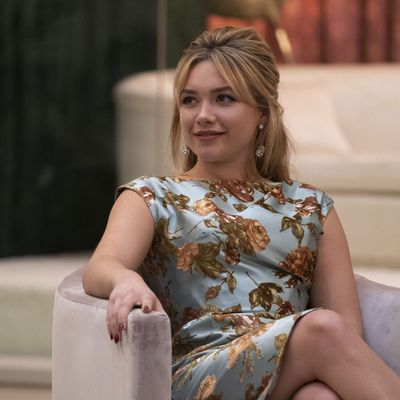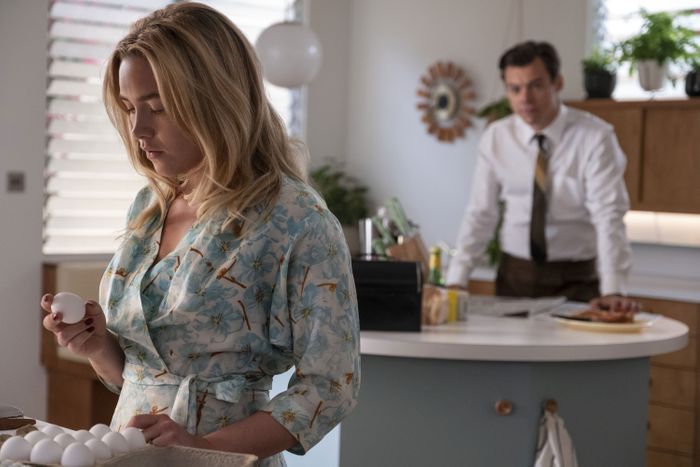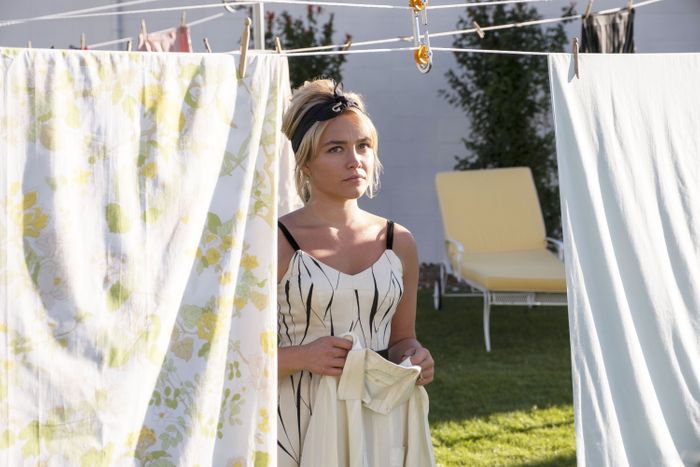
If you were among the millions who saw Don’t Worry Darling recently, you may have left the theater puzzled and uncertain as to what you just watched. It’s not just you, darling. It’s a confused film made in a confused era with confusing punctuation. It’s a mishmash of what feels like two or three screenplays that never quite jell as one story. (There may be some truth in that considering its provenance as a Black List script written by Dick Van Dyke’s grandsons, then rewritten by Katie Silberman with input from director Olivia Wilde.) Disparate plot points and tones feel pasted together by a bombastic score, strong performances, and repeating montages reminiscent of Zoolander’s hypnosis scene (but not played for laughs). Attention wanes, moments are shockingly out of place, then it cuts to black and credits roll.
There is a long list of credits in this medium-high-budget film starring Florence Pugh, Harry Styles, and Chris Pine. I counted at least 11 people in “health and safety” or some other form of COVID-precaution work; knowing that the film began production in October 2020, long before vaccines were widely available, that level of caution makes sense. A position absent in the credits is an intimacy coordinator, who gives guidance in emotional and physical safety in shooting sex scenes. That role has become more common on sets in recent years, though it is not required or regulated the way that COVID compliance or stunt safety is. A source close to the production explained, “The most respectful thing you can do is ask the cast what they want, which is what Wilde did, and they said no.” Whether this was decided before two of those three people began a relationship, and at what point that relationship was revealed to Pugh, is unclear.
Reports on the production seem confused. But there is a long history of damaging prerelease press for women directors making bigger-budget films, especially those featuring big male stars. By the Sea (directed by Angelina Jolie and starring Brad Pitt) is a recent example, and Ishtar (directed by Elaine May and produced by and starring Warren Beatty) is a classic example. Coincidentally, those are two of my favorite films. The press was so bad on Ishtar before anyone had watched it that it led May to declare, “If all of the people who hate Ishtar had seen it, I would be a rich woman today.” No matter. May never directed another feature film after that unfair flop in 1987.
There was more than sexism at play with Ishtar press; the film’s own studio had recently changed leadership, and the new heads of production wanted projects approved by the old regime to tank. It was an inside job. And while there is sexism and Schadenfreude for the rich and pretty at play in the gossip reporting on Don’t Worry Darling, the film as observed is composed of simplistic political stabs and a lack of strong direction. Scenes work individually but don’t tie together with any real emotional, political, or even logical cohesion. While not a particularly enjoyable watch, it is instructive, with a few glaring weaknesses that highlight where Hollywood is currently well meaning but can’t quite get it right. (Warning: many spoilers ahead.)
Everyone wants to be Jordan Peele.
There is a big twist in Don’t Worry Darling — one that anyone who has seen or read about recent slavery films Alice or Antebellum could guess from the trailer. The past several years have brought us a bevy of “social thrillers,” as Peele called Get Out and the films it that inspired it. (Bluntly, that is a silly name for a subgenre. Most horror films, including the trashiest and goriest, are about conformity, isolation, and social issues.) The success of Get Out has encouraged filmmakers who have no affinity for the form to make horror-adjacent films. It’s disappointing to see so many BIPOC filmmakers try to imitate Peele, but when white women like Wilde start doing it, it’s a clear sign that the trend has reached its end point. The horrorish imagery and sounds in Don’t Worry Darling feel like repetitive weak links, especially with and compared to the scenes of candy-colored parody. (This is helped by strong comedic performers including Kate Berlant, Nick Kroll, and Wilde herself.)
“Race-blind” casting aims for diversity without intersectionality or the nuance of real experience.
Kiki Layne, who plays Margaret in the film, has stated that much of what she shot was cut. Margaret is the “Cassandra” character who notices something is wrong in the fictional town of Victory before Alice (played by Pugh) catches on. In Silberman’s script from February 2020, Margaret’s appearance in the second scene kick-starts the conflict. But in the final version, instead of running into Margaret while driving in the desert, it became a simple romantic scene between Jack (Styles) and Alice. The first glimpse that something is amiss instead comes shortly afterward, when Alice cracks an egg and discovers it to be an empty shell — much like the town of Victory and, unfortunately, the finished film. In case we missed the symbolism, she cracks empty egg after empty egg. This was not in the February 2020 screenplay, and its placement about ten minutes into the film renders the red herring about Victory men possibly manufacturing weapons (supported by mysterious aircraft and earth shaking) useless. Instead, we know early on nothing is quite real, then hold there for a solid hour of Pugh’s puzzlement. Without Layne’s Margaret as a precursor and later foil, the plot stays in this stasis.
Why were Layne’s scenes cut? (And why was she not at the Venice premiere?) A generous read is that perhaps the filmmakers realized it was odd to make the only Black woman with a speaking role the character whom everyone calls “crazy” and won’t listen to without addressing that she is Black. One clear sign that this 1950s era is not the real 1950s is that Black people could live in mostly white suburbs without issue or comment. But how is it that, in this film, MAGA-ish incel villains are sexist but not racist? It is a white-feminism fail tackling sexism in isolation.
Talented male stars are resistant to playing light romantic leads.
Another unfortunate current genre bias is the dearth of talented male actors willing to play the romantic leads in light comedies. The Grants, Cary and Hugh, excelled at this in years past. Ryan Gosling could be their successor, but after finding fame in The Notebook, he preferred to make dark dramas. (He referred to one of these, Drive, as “Pretty in Pink with a head-smashing.”) Styles is another actor who, judging from his best and worst moments in Don’t Worry Darling, would seem to excel at romantic comedy rather than heavy drama. But his film choices so far have been a war film (Dunkirk), a period drama (My Policeman), and this, a Franken-genre thriller.
This is when we get into what is most confused and confusing about Darling. Infamously, Styles’s role was originally to be played by Shia LaBeouf, who has a more menacing presence. As written by the Van Dykes, this character was an ex-husband who kidnapped his more successful wife and trapped her in a regressive fantasy. In Silberman’s screenplay, Jack was a stalker, a random pharmacy rep from the hospital who wants to “save” Alice from her difficult career as a doctor. When he says, “I love you,” Alice tells the man posing as her husband that she doesn’t care and that he’s psychotic.
At some point, Wilde started making a different movie: a romance. The simple sex scenes written between Jack and Alice became about him getting her off. (“Men don’t come in this film,” Wilde proudly said to Variety about a film in which men keep women in comas so they can enact their regressive sexual fantasies without the women knowing.) A scene in the Silberman screenplay in which Jack has to “fend for himself” and cook his own dinner became another scene about pleasing women. “I am your chef tonight,” says Jack sweetly. (This charming scene leans into Styles’s strengths.)
Wilde’s comment to Vogue about an awkward dinner cunninglingus scene was that she wanted the audience to “realize how rarely they see female hunger and, specifically, this type of female pleasure.” But does that positive message of sexual empowerment work in a horror film about lack of consent?
In the same interview, Wilde said, “I kept saying, ‘Why isn’t there any good sex in film anymore?’” At what point did a film about Jordan Peterson–type incels become a sexy film about a man who has to kidnap a woman and put her in a coma in order to please her? Whenever this decision was made, there was no intimacy coordinator on set to advise the change. And it shows.
There was so much to look forward to with this feminist film featuring beautiful people, costumes, and production design. But, like wearing a “Feminist AF” T-shirt to the revolution, good intentions are not enough.






